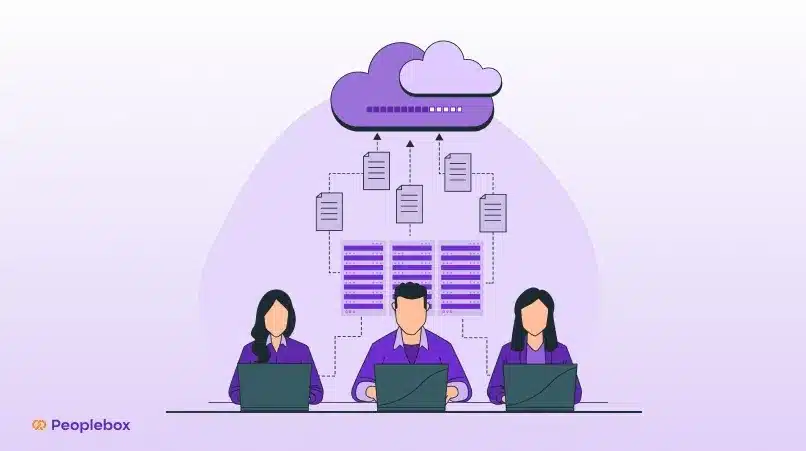You’re having a normal day at work–conducting one on one meetings, stand-ups, status reports, and other meetings.
Your direct reports are taking a break around the water cooler, chatting about their lives.
You may meet up with a colleague for a lunch meeting at the office cafeteria.
These seemingly everyday conversations have a greater purpose–they are the glue that holds people together, giving them a sense of belonging.
In-person meetings allow you and your direct reports to work collaboratively and create trusting and productive relationships.
It doesn’t have to be any different for remote managers and their distributed teams.
But it will require much more planning and coordination to build a rapport across a screen because research shows that communication = 55% body language + 38% tone of voice + 7% actual words.
You have to work doubly hard to connect with your direct reports on a human level.
Remote one on one meetings are a different ball game altogether because:
- You may miss important nonverbal cues and misinterpret the message.
- You’ll need more time to understand what is going on within the team and identify potential conflicts or tensions.
- You’ll find it harder to keep track of progress across various projects and easily identify stumbling blocks.
One on one meetings offer a dedicated, private, and more flexible space for managers to focus on the challenges and long-term goals of their direct reports, and exchange personalized feedback with each other.
Don’t discount the value of these meetings.
The whole point of a one on one meeting is that you pay attention to what your direct reports are saying and find out what you can do to help them grow.
And to have effective and impactful remote one on one meetings, you’ll need to start with having a well-planned agenda, set collaboratively with your direct report.
What is a meeting agenda and why is agenda setting important?
Simply put, an agenda is a plan for a meeting which lists the items to be discussed and the sequence in which they will be discussed.
With an agenda, your one on one meetings will not veer off-topic and you can make the most of your time with your direct report.
But, in remote one on one meetings, it is even more important that you have a collaborative agenda because you don’t meet your direct report in the office every day.
You don’t know what’s going on inside her head–whether she resents something, whether she’s struggling with something but unable to approach you, whether she’s happy with her remote status and circumstances.
Little things like these can build up and create significant problems in the future, when they become more challenging to resolve.
You and your direct report lack the daily face-to-face contact that regular workers take for granted, like spontaneous catch-up sessions or simply dropping by to ask a quick question.
So you must save all your queries and concerns for your weekly remote one on one meeting.
This necessarily makes these meetings longer than regular one on one meetings.
A focused and actionable agenda tells you what should be done before and during a meeting.
CEO coach Kim Scott recommends letting your direct reports set the meeting agenda. A remote one on one meeting is really their time, not yours.
Hence, a collaborative approach where both of you provide your inputs work best for a one on one meeting .
Don’t forget to give your direct report a chance to review the final agenda before the meeting.
One on One Meeting Agenda Setting: How does it help?
You may feel that a weekly 30-60 minute meeting does not need an agenda. But you’d be surprised at how much more effective you can make it by taking the time to set a shared agenda with your direct report.

1 Makes it about them – direct reports
A one on one meeting is really for your direct reports to share their thoughts and feelings with you.
When your direct report sets the agenda, she ensures that all topics critical to her are included.
It is natural to forget a few things when you’re constantly juggling priorities.
Give your direct report more autonomy over how the meeting will go, and you’ll be able to find out what her intent is.
It will also make her feel wanted and important. Moreover, it will give you a chance to prepare and offer informed suggestions.
As an added bonus, you’ll bond better with her since she will grow to trust you when she finds that you’re transparent about your one on one meetings.
2 Structures the meeting
We know your schedule is probably always full with back-to-back meetings. There are many time-sensitive managerial tasks that cannot be delayed.
This leaves you with less time to have regular remote one on one meetings. Thus, it is even more important to streamline your meetings by creating a structured agenda.
Allot an approximate duration for each key topic and the sequence in which they will be discussed.
Recommended: Be slightly flexible with the agenda. Keep some buffer time as far as possible. Maybe your direct report wants to share something that’s particularly troubling her.
A good manager is available when her direct report is depending on her for support and guidance.
Your remote direct report does not have the luxury of walking up to you for a quick chat when something’s bothering her.
The one on one meeting is the only time she can actually see you and speak to you.
An IM or email just doesn’t cut it.
For this reason, you’ll spend more time chatting with a remote team member than you would with an in-house direct report.

Let your direct report share about her personal life because it helps you find commonalities that you can use to connect with her more deeply.
In the current crisis, you’ll find that an empathetic approach works best with remote teams.
Icebreaker questions are ideal to ease into the conversation and discuss more serious matters ahead.
Tip: You may want to dip into our exhaustive list of 500+ questions for one on one meetings to help you discuss practically anything!
3 Saves time
How many times have you started a meeting only to realize that you can’t remember what you had intended to discuss?
Or you don’t have the relevant data or files and you put off the topic for later (and it gets forgotten)?
Scrambling to remember what you need to talk about doesn’t just waste time, it also puts a huge dent in morale.
You need to show that your direct report is valued and her time is just as important as yours, and arriving unprepared to meetings isn’t a good way to go about it.
Ariana Huffington, co-founder of the Huffington Post, feels,
If we have a clear agenda in advance and we are fully present and fully contributing, the meetings do go much faster.
Having an agenda will ensure that you know what you need to talk about, and you also have notes from your previous one on one meetings.
You will accomplish much more this way.
4 Focuses on action items
What is the point of discussing issues if no action is taken?
And how do you track progress without assigning action items?
Agenda setting makes ‘actioning’ more efficient and streamlined.
With an agenda in hand, you can ensure three things:
- Your direct report has worked on action items set in the previous meeting
- You’re able to assign appropriate actions for topics you’re discussing in the current meeting
- When you assign future action items, you can track the progress of issues discussed previously.

A sense of responsibility works wonders to motivate employees to work toward achieving their goals.
Hence, the first step to getting the outcomes both of you want is to set an actionable agenda.
OKR Software – Used by 500+ Companies
Transform your managers into leaders through personalized coaching, bite-size learnings and make it super easy for them to have meaningful 1:1s, check-ins, and align goals(OKRs).
5 Maintains continuity across remote one on one meetings
Despite all your planning, it is possible that you don’t get to discuss everything on your agenda or you need more time to thresh out an issue.
An agenda comes in super handy at such times. It prevents each remote one on one meeting from becoming an isolated discussion.
You can review your notes from your previous meeting agenda and pick up from where you left off with no loss of time.
This continuity is especially helpful when discussing things like career goals and feedback.
Recommended: Just like you created a collaborative agenda, it is a good practice to have shared notes after the meeting. You can also use a one on one meeting software to archive your meetings.
In Summary
An easy way to make your remote one on one meetings more fruitful and powerful is to set an agenda each time.
Staying organized will help you manage your remote team effectively and steer them through all manner of crises.







